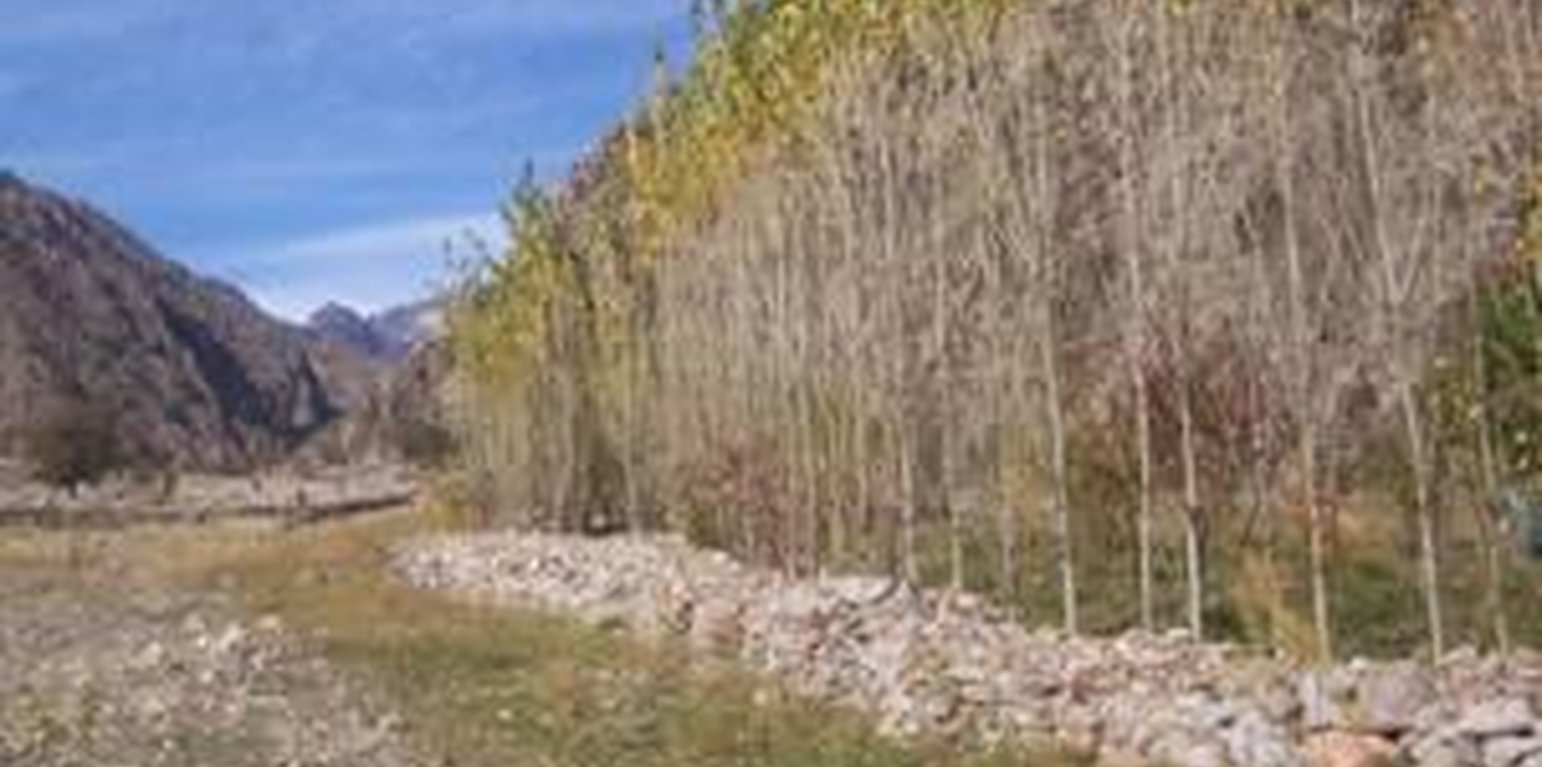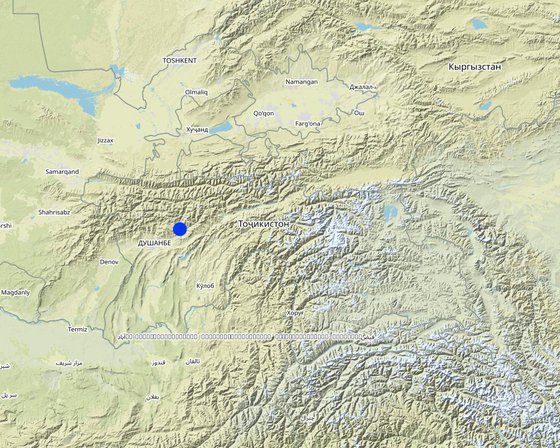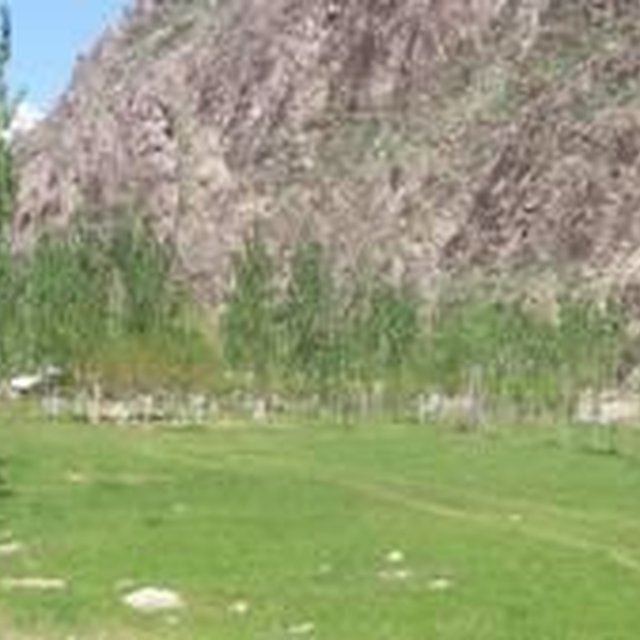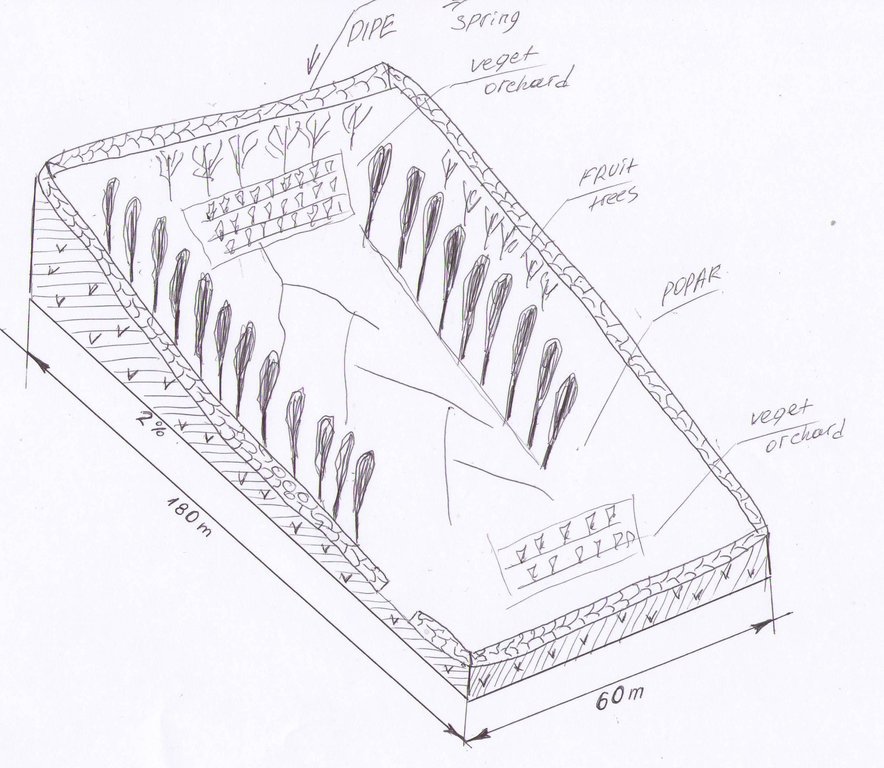



The area in question is a very narrow, flat valley floor, 95% of which was covered in stones and boulders, and devoid of vegetation, both grass and trees/shrubs. The stones in the area were cleared and used to build a protecting, perimeter wall (approx. 1.5 m high). This was then supplemented by an inner row of fast growing poplar trees. The stone clearing has resulted in deeper soil within the protected area that has led to far greater vegetation coverage, such as grass (that can be cut and used as fodder), forest and orchard trees and vegetable gardens. Irrigation was provided to the area by a small diameter poly pipe from a permanent spring. The area is now being extended to almost double the size of the initial walled agro-forest area.
Purpose of the Technology: The farmer’s primary aim, in initiating and continuing this SLM approach, was to “leave a legacy of improved land” for future generations, recognising how little flat and potentially productive land there is in this high, narrow valley location. Clearing the land of stones and building a walled enclosure that was irrigated greatly assured the quantity and quality of fodder for his animals, as they remain fenced in beside his village home almost all year. Fruit and vegetable production was also greatly improved.
Establishment / maintenance activities and inputs: The family commenced stone clearing and wall construction in 2005. The next task was tree planting; poplar trees were planted around the wall's perimeter. The irrigation source was tapped into using a poly pipe. The vegetable gardens are seasonal and their plants change with the seasons and the family’s needs. Stone removal continues even now, to improve the soil in the walled area. The farmer hopes to extend the walled area in the future.
Natural / human environment: Before the family began clearing stones and building the wall, this land had almost zero productivity. This area has a shortage of cultivated land and with increases in popluation and continued food insecurity, cultivated land is at a premium.

ទីតាំង: Kushon village, Romit Jamoat, Vahdat, Central District of Tajikistan, ប្រទេសតាហ្ស៊ីគីស្ថាន
ចំនួនទីកន្លែងបច្ចេកទេស ដែលវិភាគ:
ការសាយភាយនៃបច្ចេកទេស: ត្រូវបានផ្សព្វផ្សាយត្រឹមតំបន់មួយ (approx. < 0.1 គម2 (10 ហិកតា))
តើស្ថិតក្នុងតំបន់ការពារអចិន្ត្រៃយ៍?:
កាលបរិច្ឆេទនៃការអនុវត្ត: តិចជាង 10ឆ្នាំមុន (ថ្មី)
ប្រភេទនៃការណែនាំឱ្យអនុវត្តន៍៖










| បញ្ជាក់ពីធាតុចូល | ឯកតា | បរិមាណ | ថ្លៃដើមក្នុងមួយឯកតា (somoni) | ថ្លៃធាតុចូលសរុប (somoni) | % នៃថ្លៃដើមដែលចំណាយដោយអ្នកប្រើប្រាស់ដី |
| កម្លាំងពលកម្ម | |||||
| Stone clearing | Persons/day | 15,0 | 50,0 | 750,0 | 100,0 |
| Wall building | Persons/day | 15,0 | 50,0 | 750,0 | 100,0 |
| Tree planting | Persons/day | 10,0 | 25,0 | 250,0 | 100,0 |
| Vegetable garden | Persons/day | 20,0 | 15,0 | 300,0 | 100,0 |
| សម្ភារៈ | |||||
| Tools | Pieces | 6,0 | 16,66666666 | 100,0 | 100,0 |
| សម្ភារៈដាំដុះ | |||||
| Trees | Pieces | 100,0 | 10,0 | 1000,0 | 100,0 |
| Plants for vegetable garden | - | 1,0 | 450,0 | 450,0 | 100,0 |
| សម្ភារៈសាងសង់ | |||||
| Irrigation pipe | meter | 700,0 | 3,0 | 2100,0 | 100,0 |
| Wall | meter | 500,0 | 7,0 | 3500,0 | 100,0 |
| ថ្លៃដើមសរុបក្នុងការបង្កើតបច្ចេកទេស | 9'200.0 | ||||
| ថ្លៃដើមសរុបក្នុងការបង្កើតបច្ចេកទេសគិតជាដុល្លារ | 2'044.44 | ||||
| បញ្ជាក់ពីធាតុចូល | ឯកតា | បរិមាណ | ថ្លៃដើមក្នុងមួយឯកតា (somoni) | ថ្លៃធាតុចូលសរុប (somoni) | % នៃថ្លៃដើមដែលចំណាយដោយអ្នកប្រើប្រាស់ដី |
| កម្លាំងពលកម្ម | |||||
| Stone clearing | Persons/day | 10,0 | 25,0 | 250,0 | 100,0 |
| Vegetable garden | Persons/day | 50,0 | 25,0 | 1250,0 | 100,0 |
| Tree planting | Persons/day | 20,0 | 15,0 | 300,0 | 100,0 |
| Animal husbandry | Persons/day | 40,0 | 15,0 | 600,0 | 100,0 |
| ផ្សេងៗ | |||||
| Labour: Fertilising and cultivating | Persons/day | 20,0 | 15,0 | 300,0 | 100,0 |
| Labour: Random stone removal | Persons/day | 10,0 | 15,0 | 150,0 | 100,0 |
| ថ្លៃដើមសរុបសម្រាប់ការថែទាំដំណាំតាមបច្ចេកទេស | 2'850.0 | ||||
| ថ្លៃដើមសរុបសម្រាប់ការថែទាំដំណាំតាមបច្ចេកទេសគិតជាដុល្លារ | 633.33 | ||||
Before the Technology this land was almost 95% covered in rocks with almost zero carrying capacity, no productivity and no water supply. So the % increase as a result of the Technology is all related to this increase from nothing.
គុណភាពមុន SLM: 2
គុណភាពក្រោយ SLM: None
The primary aim of the farmer in introducing the technology was to improve the family’s lifestyle (livelihoods) and well being. He has easily achieved this and it seems to be getting better, year on year.